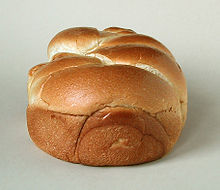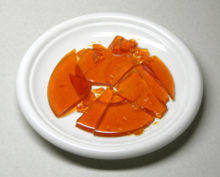- Browning (food process)
-
 The crust of brioche bread, which is golden-brown due to the Maillard reaction
The crust of brioche bread, which is golden-brown due to the Maillard reaction
Browning is the process of becoming brown, especially referring to food. Browning foods may be desirable, as in caramelization, or undesirable, as in an apple turning brown after being cut. Foods, including beverages, can turn brown through either enzymatic or non-enzymatic processes.
Enzymatic browning
Enzymatic browning is a chemical process, involving polyphenol oxidase, catechol oxidase and other enzymes that create melanins and benzoquinone, resulting in a brown color. Enzymatic browning generally requires exposure to oxygen, thus the browning that occurs when an apple, for example, is cut.
Enzymatic browning can be beneficial for:
- Developing flavor in tea
- Developing color and flavor in dried fruit such as figs and raisins.
Enzymatic browning is often detrimental to:
A variety of techniques exist for preventing enzymatic browning, each exploiting a different aspect of the biochemical process.
- Lemon juice and other acids lower the pH and remove the copper cofactor necessary for the responsible enzymes to function
- Blanching to denature enzymes and destroy responsible reactants
- Cold temperatures can also prevent enzymatic browning by reducing rate of reaction.
- Inert gas, like nitrogen, prevent necessary oxygen from reacting
- Chemicals such as sodium bisulfite and citrates
Nonenzymatic browning
Nonenzymatic, or oxidative, browning is a chemical process that produces a brown color in foods without the activity of enzymes. The two main forms of nonenzymatic browning are caramelization and the Maillard reaction. Both vary in reaction rate as a function of water activity.
Carmelization is the pyrolysis of sugar. It is used extensively in cooking for the resulting nutty flavor and brown color. As the process occurs, volatile chemicals are released, producing the characteristic caramel flavor.
The Maillard reaction is a chemical reaction between an amino acid and a reducing sugar, usually requiring the addition of heat. The sugar interacts with the amino acid, producing a variety of odors and flavors. The Maillard reaction is the basis of the flavoring industry, since the type of amino acid involved determines the resulting flavor; it also produces toast.
See also
Categories:
Wikimedia Foundation. 2010.


